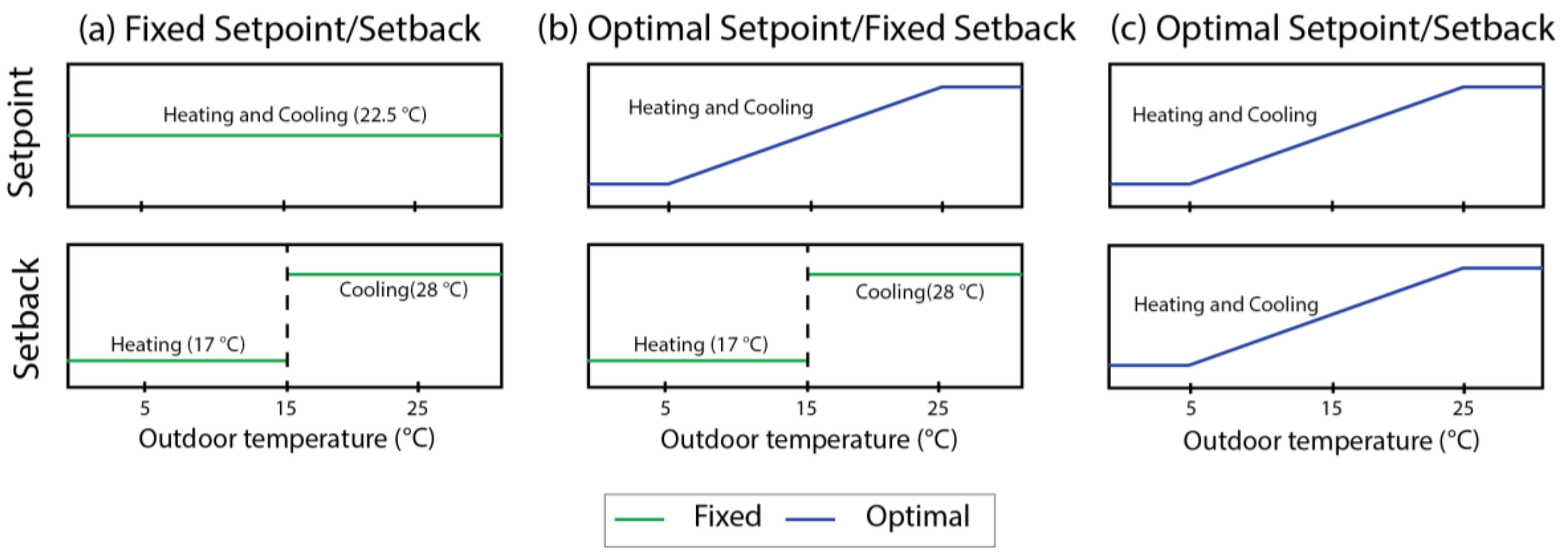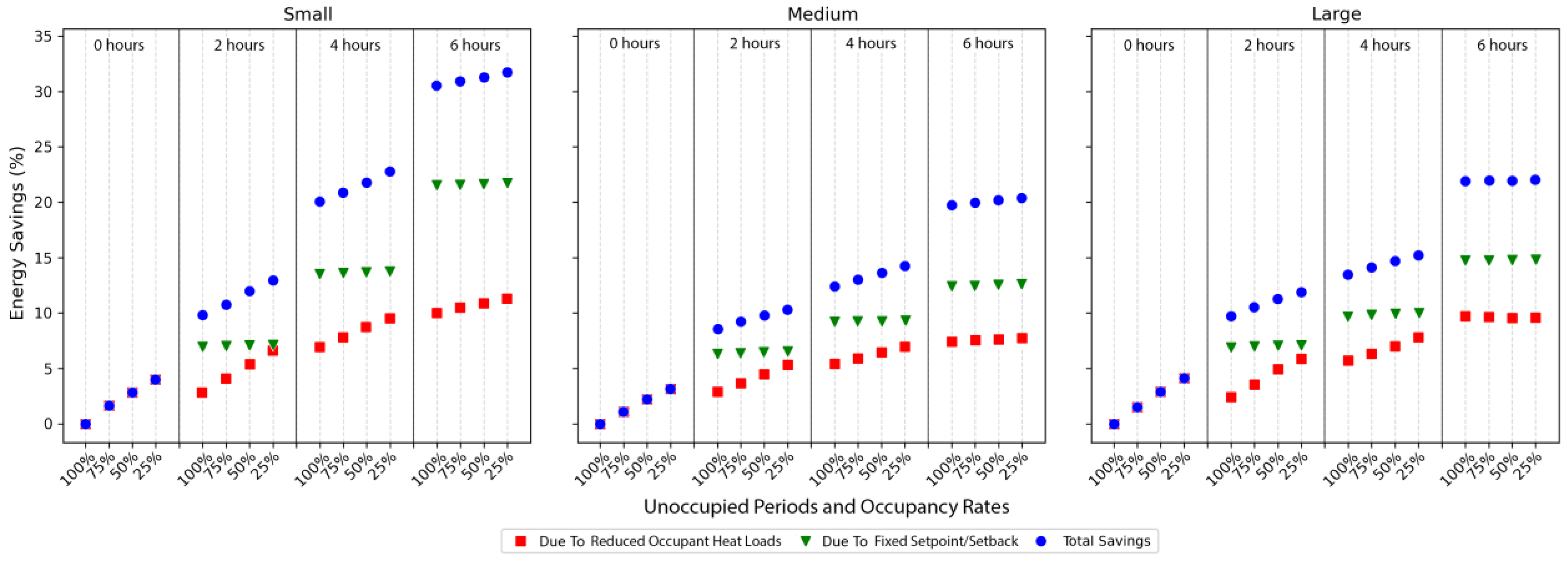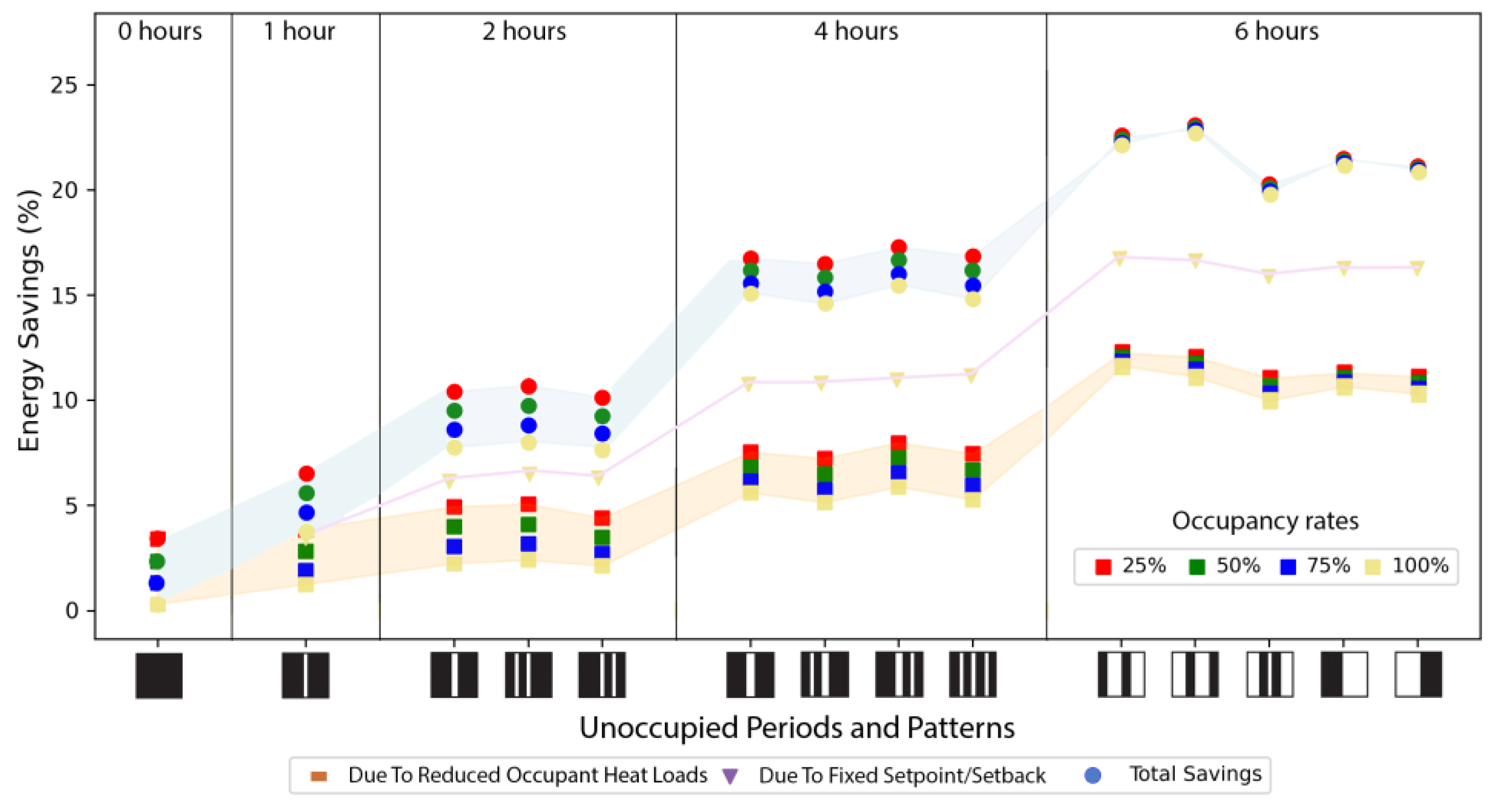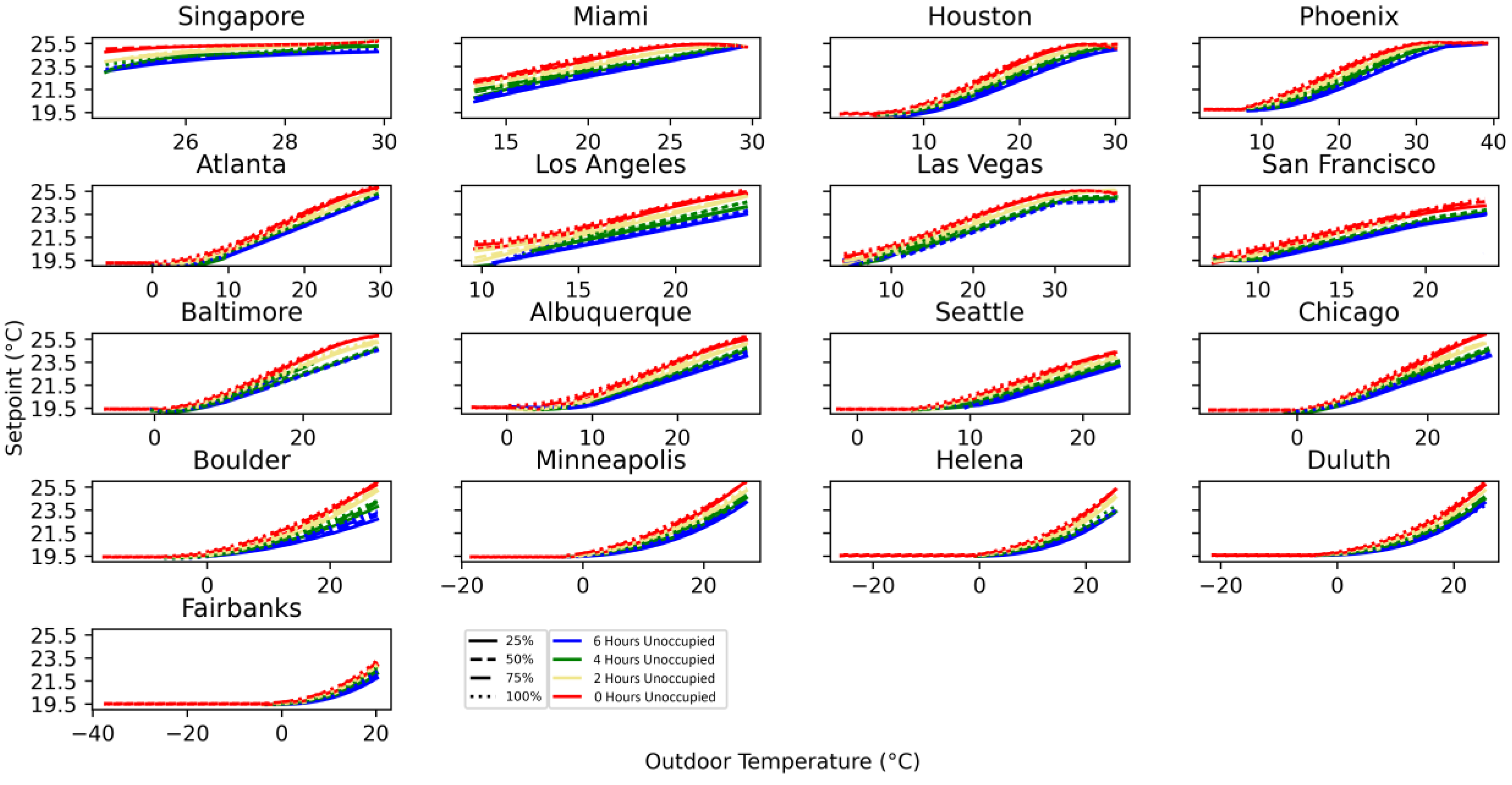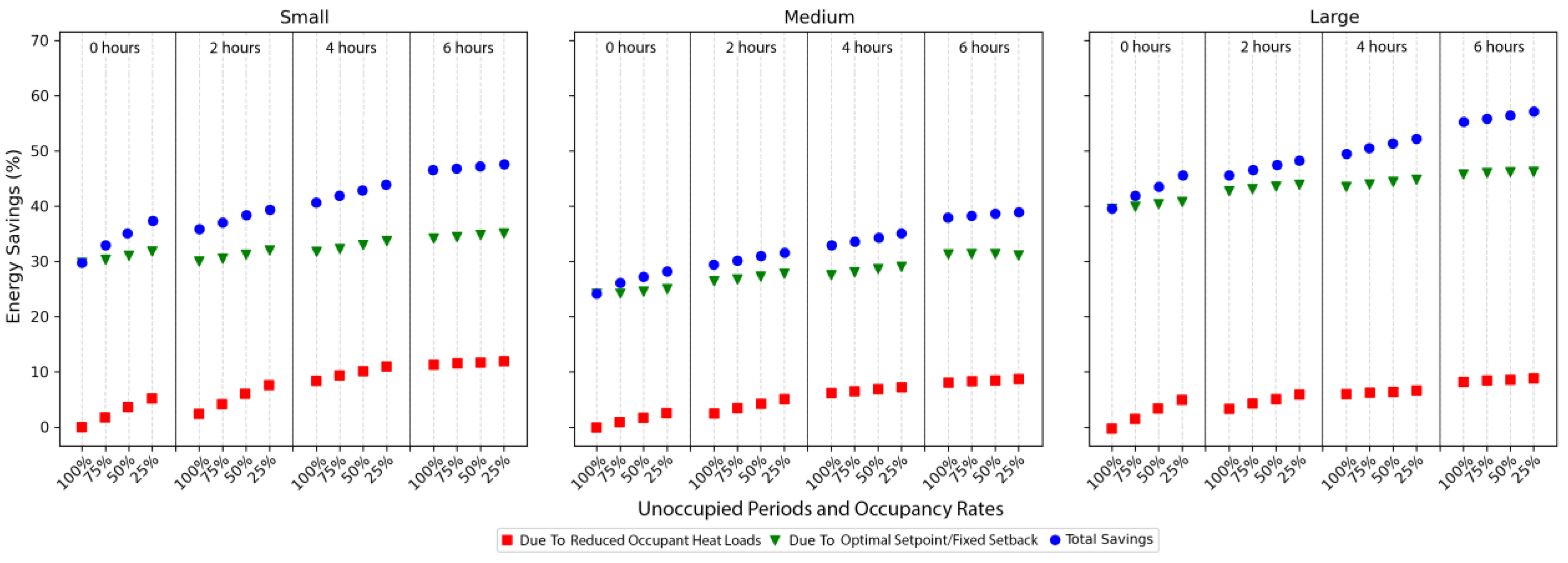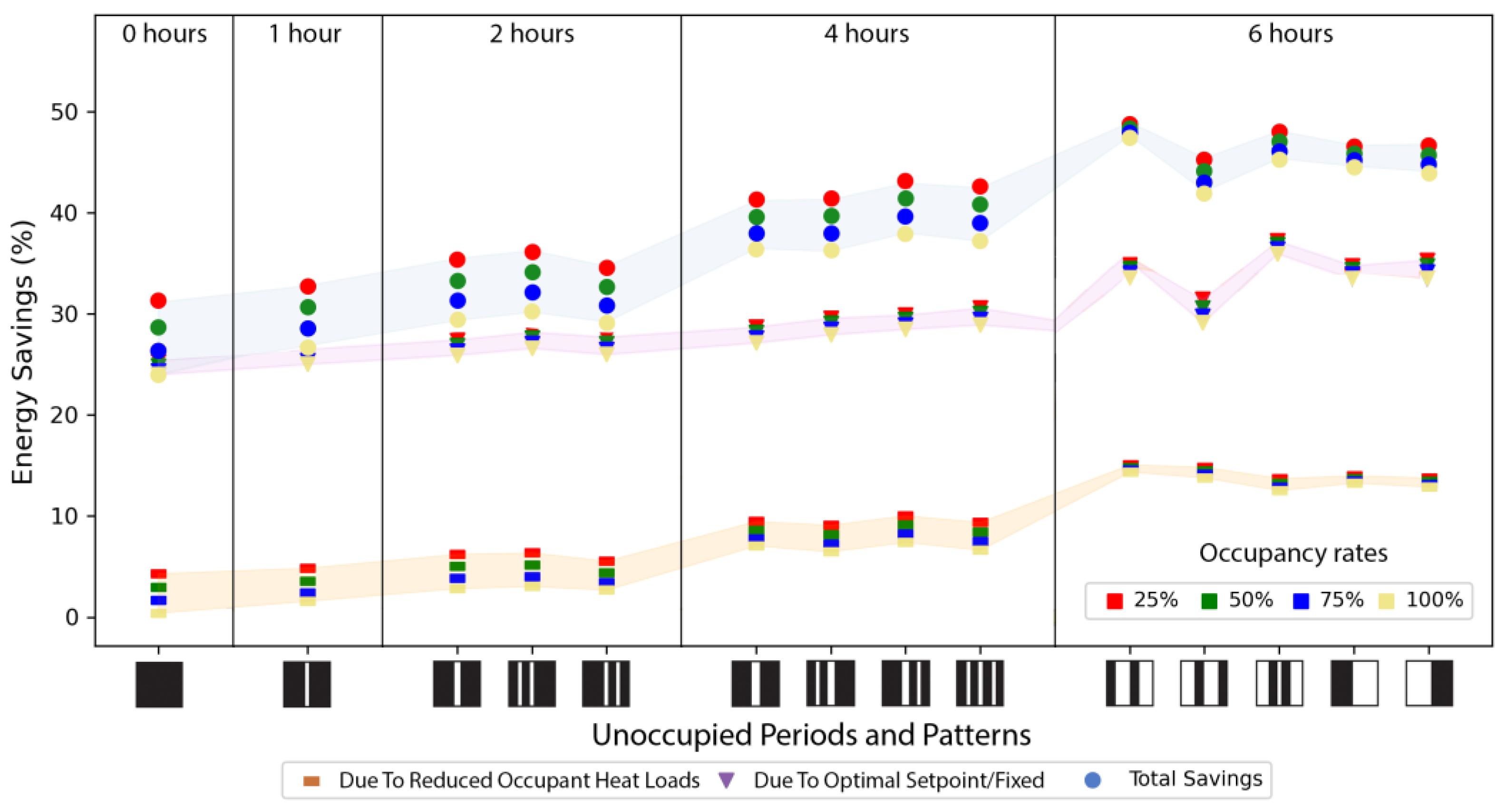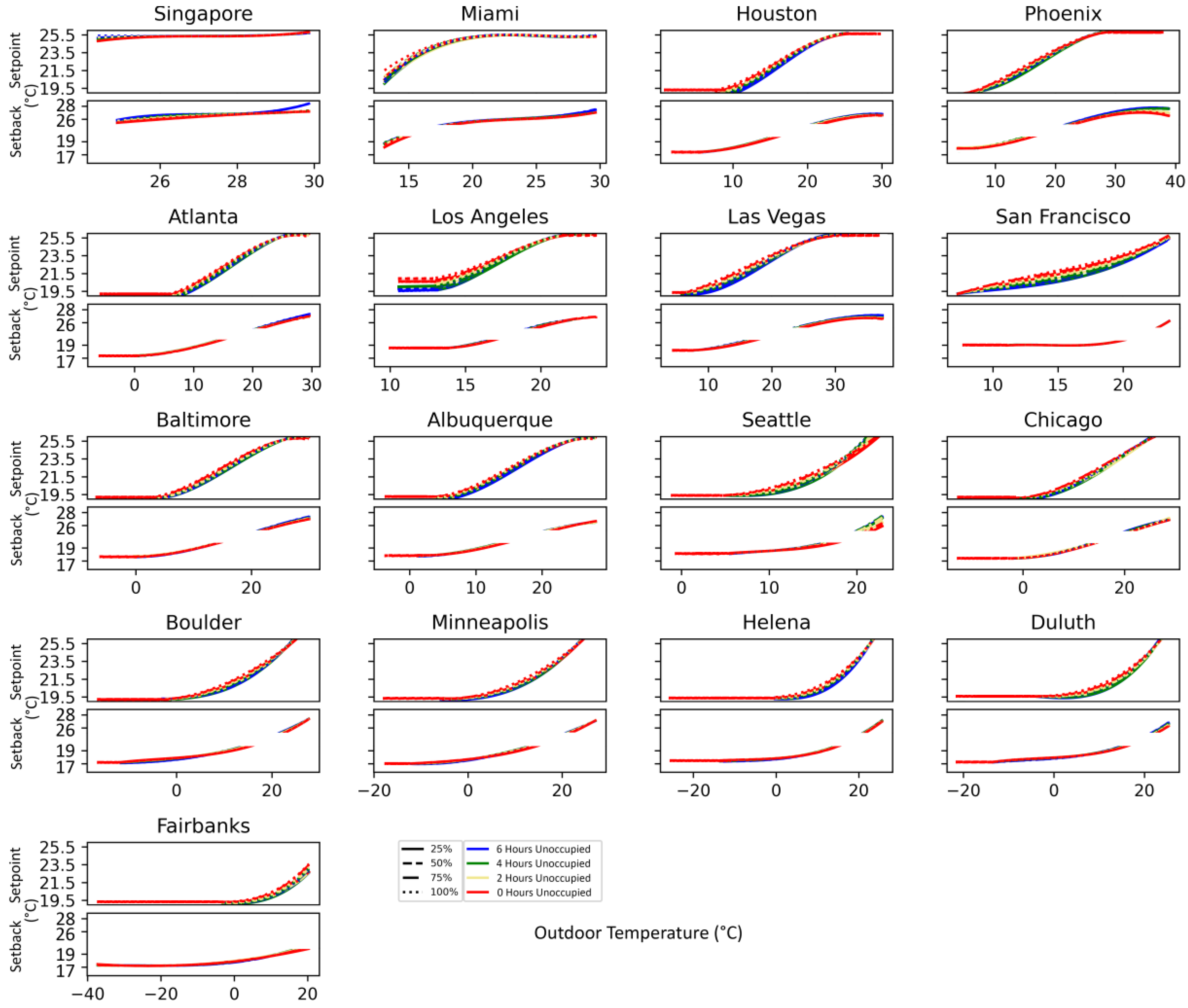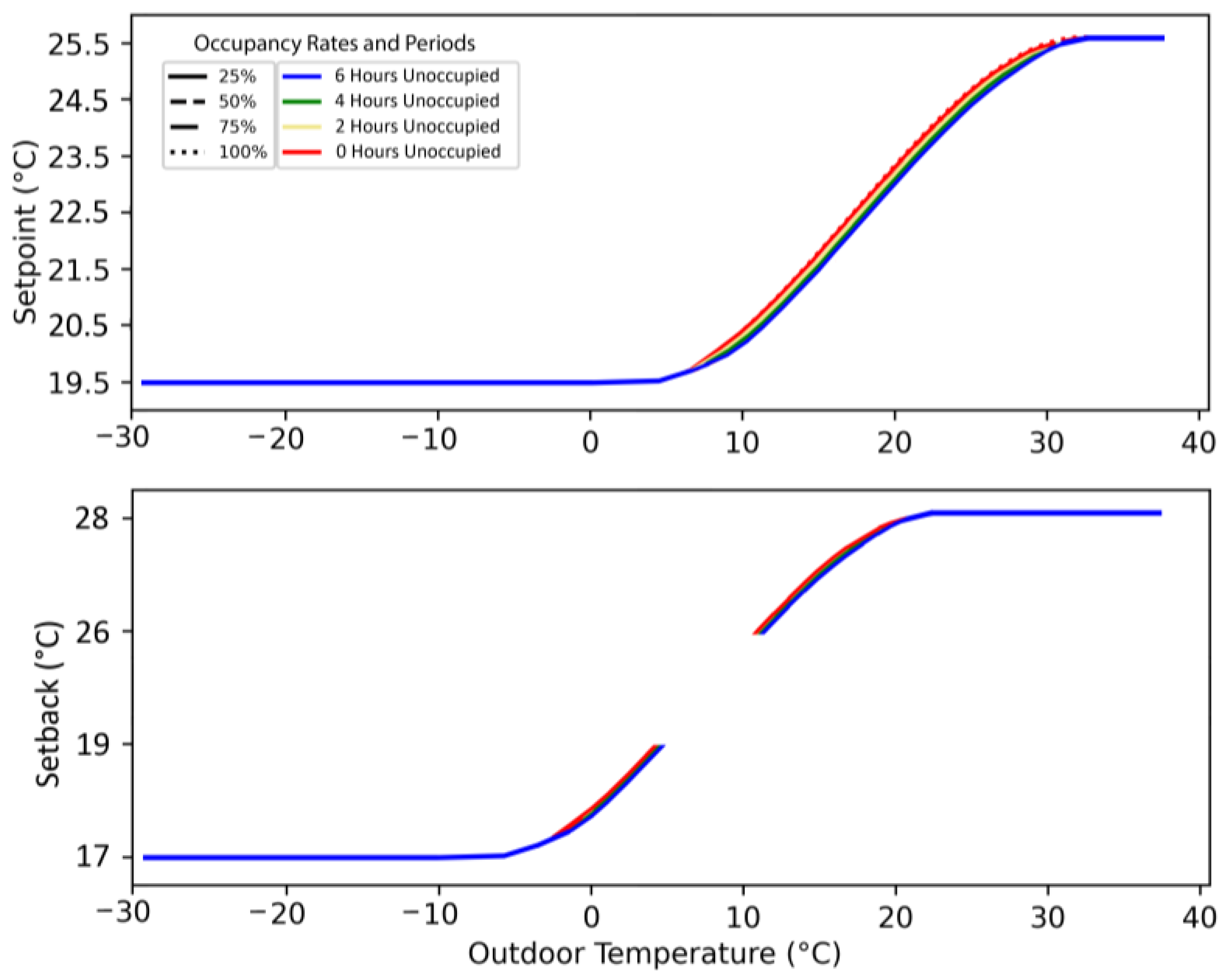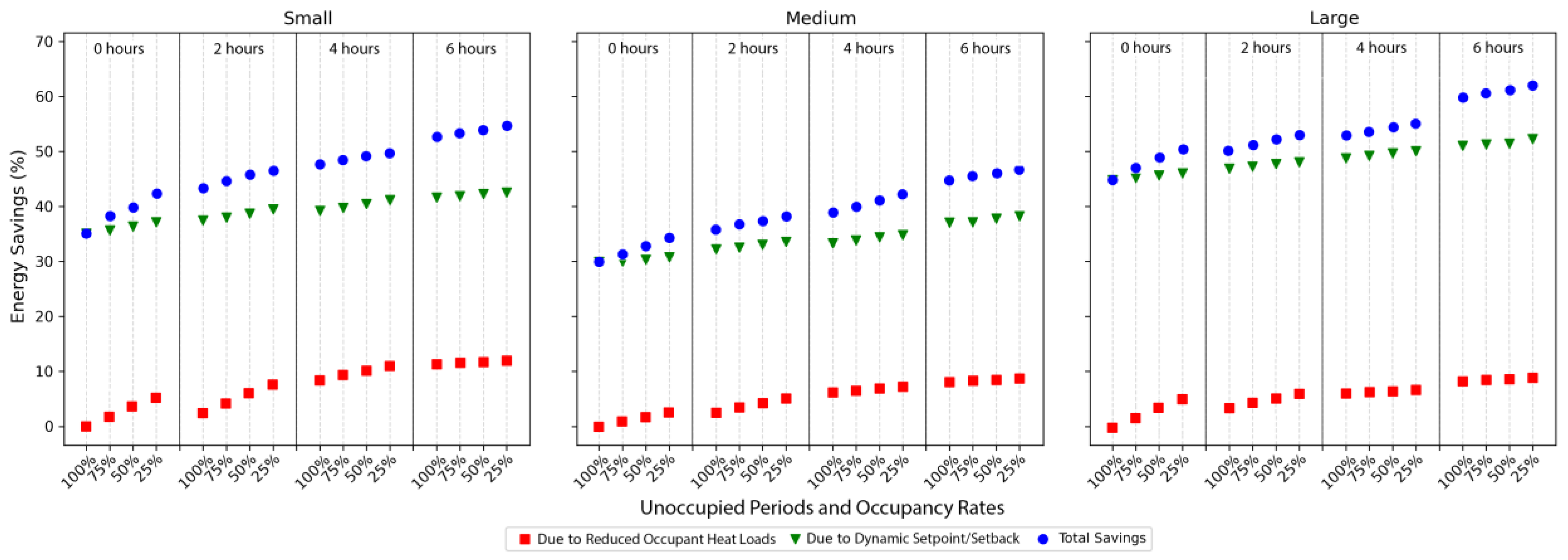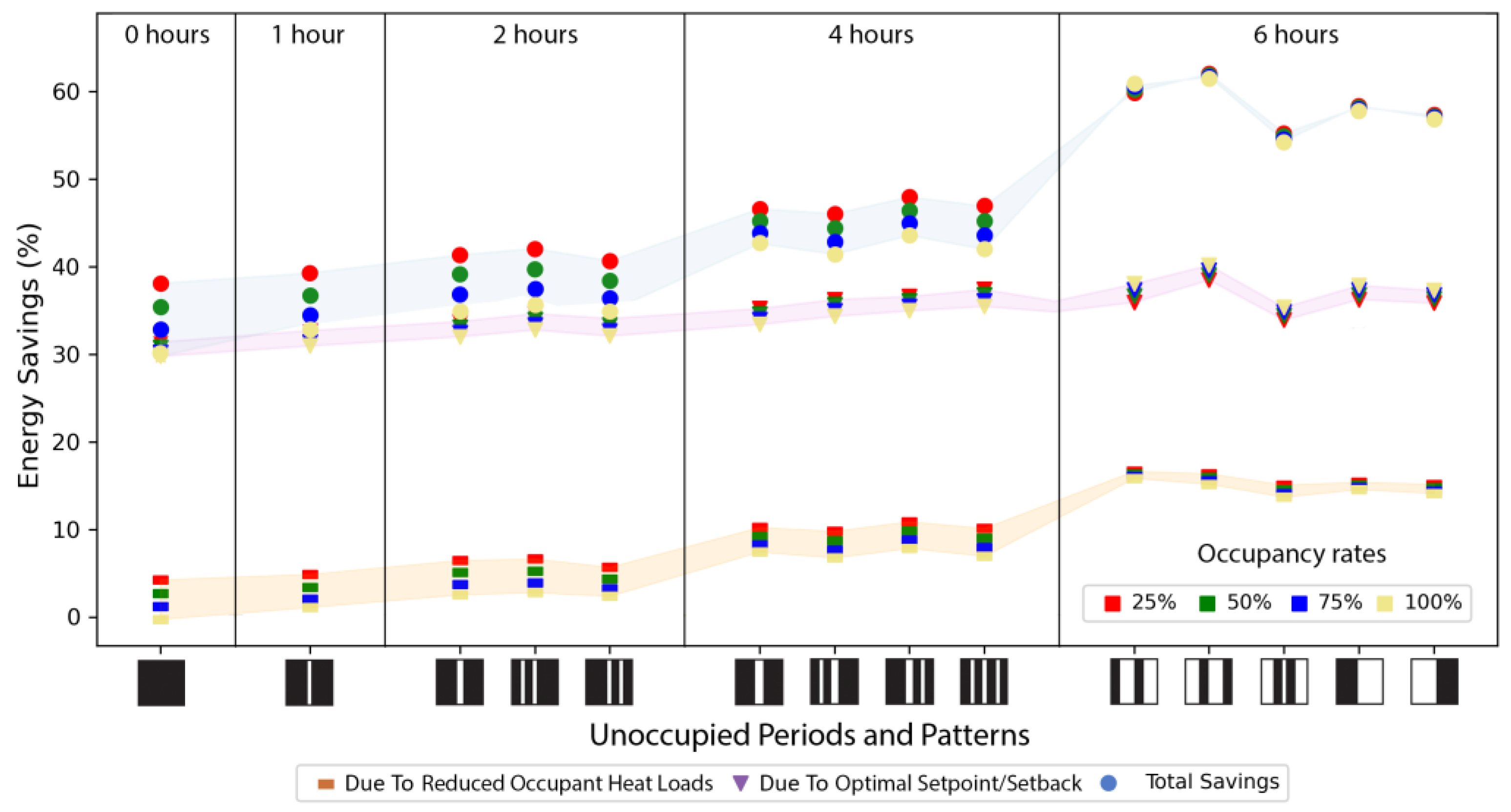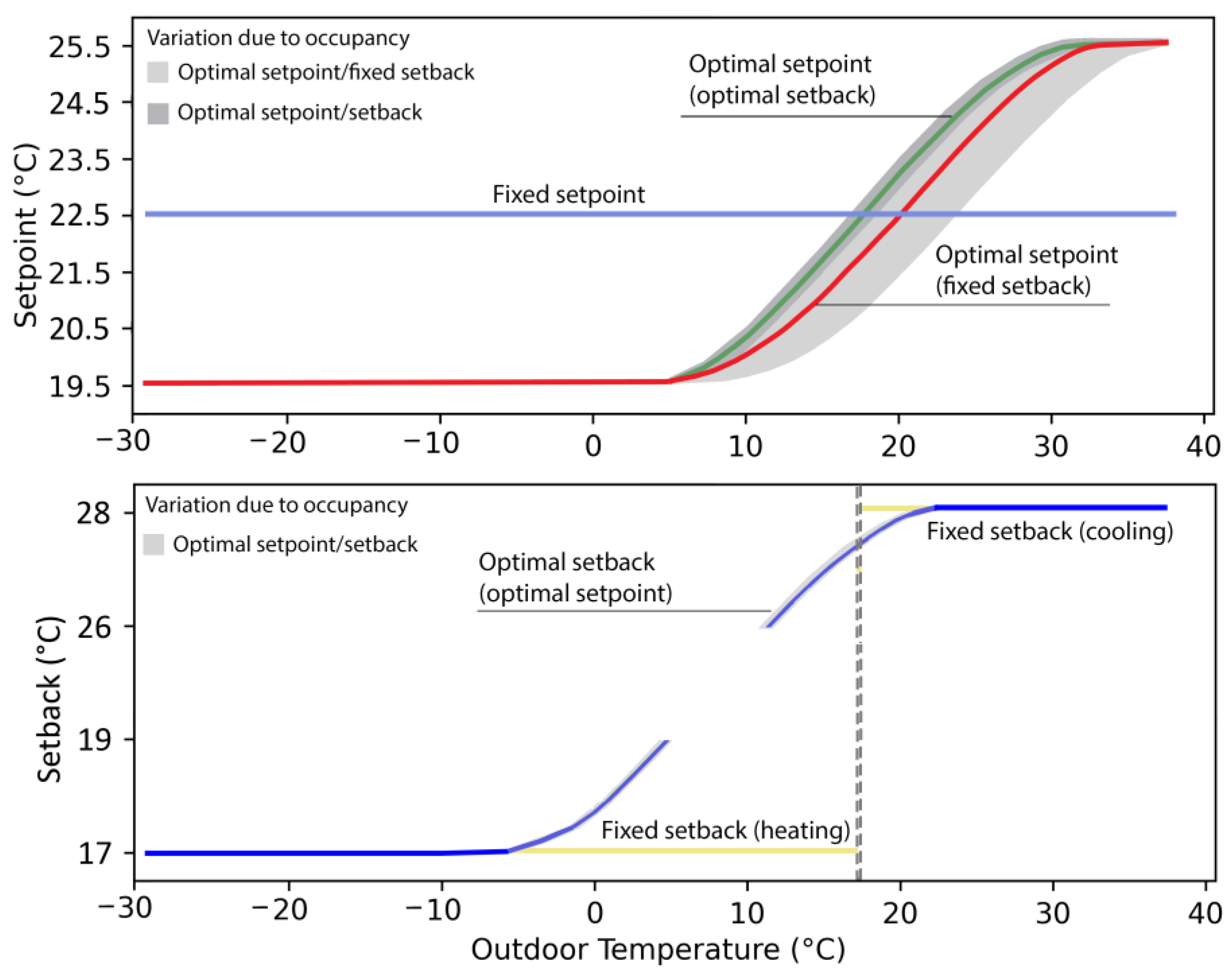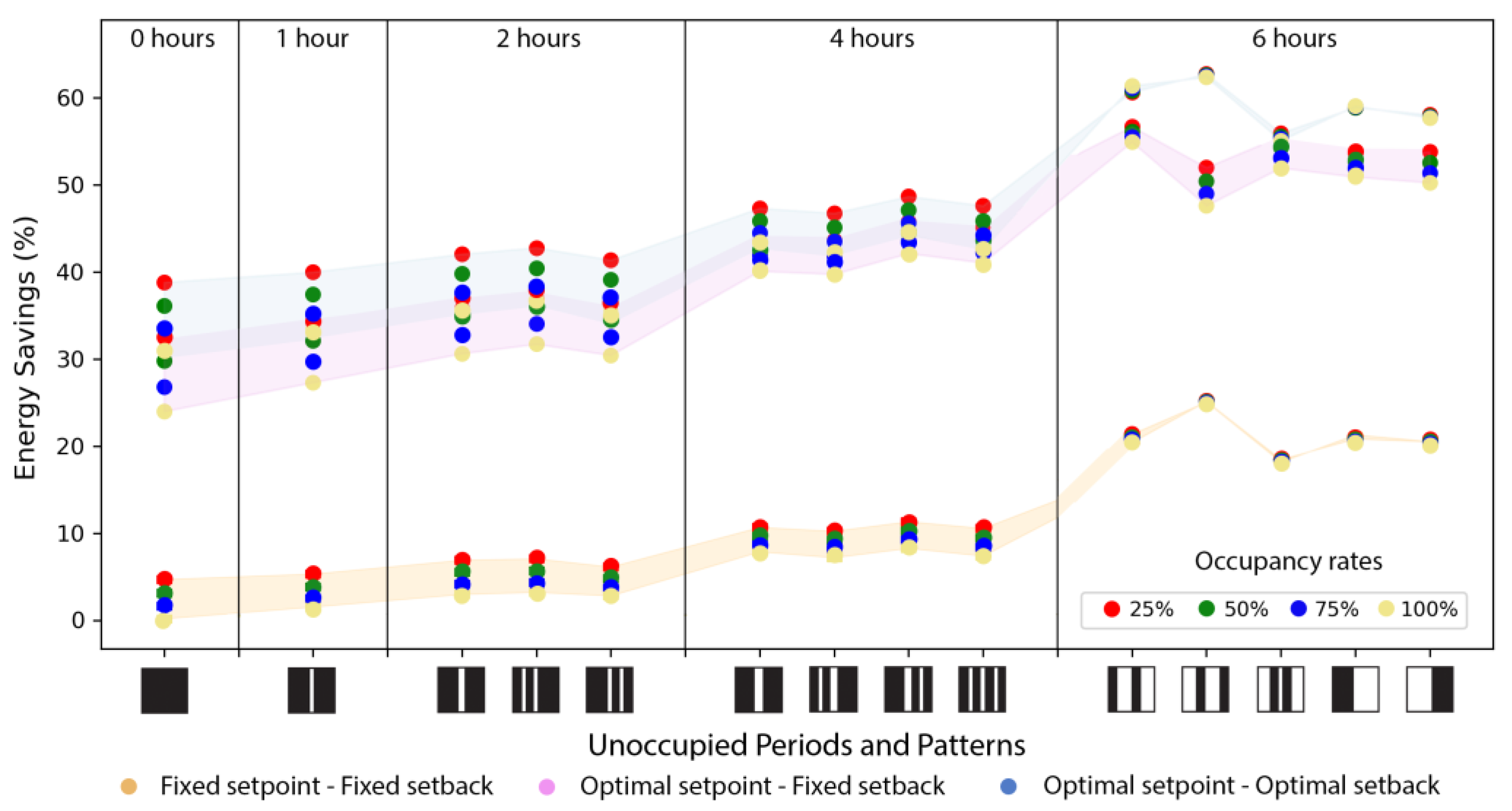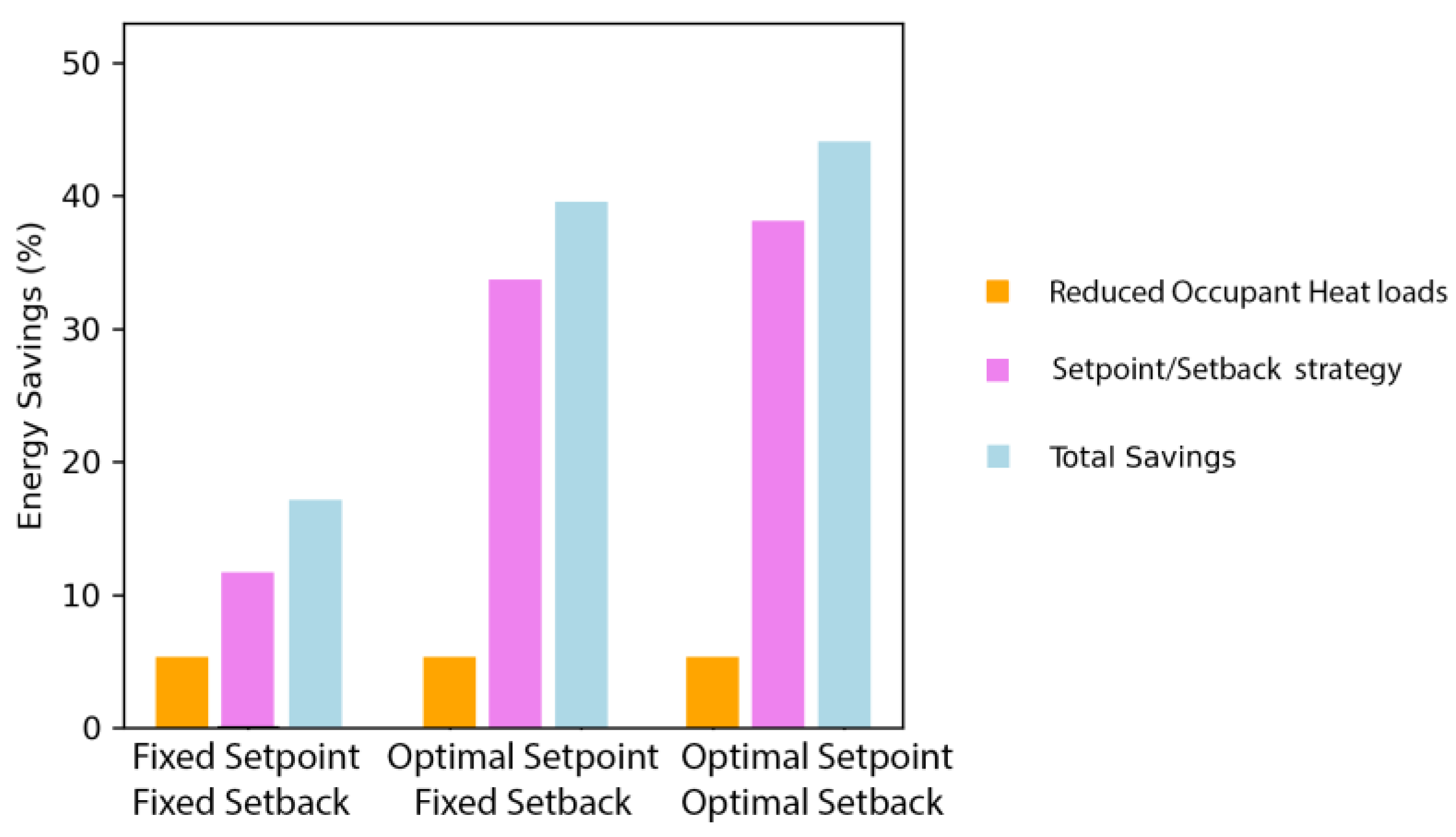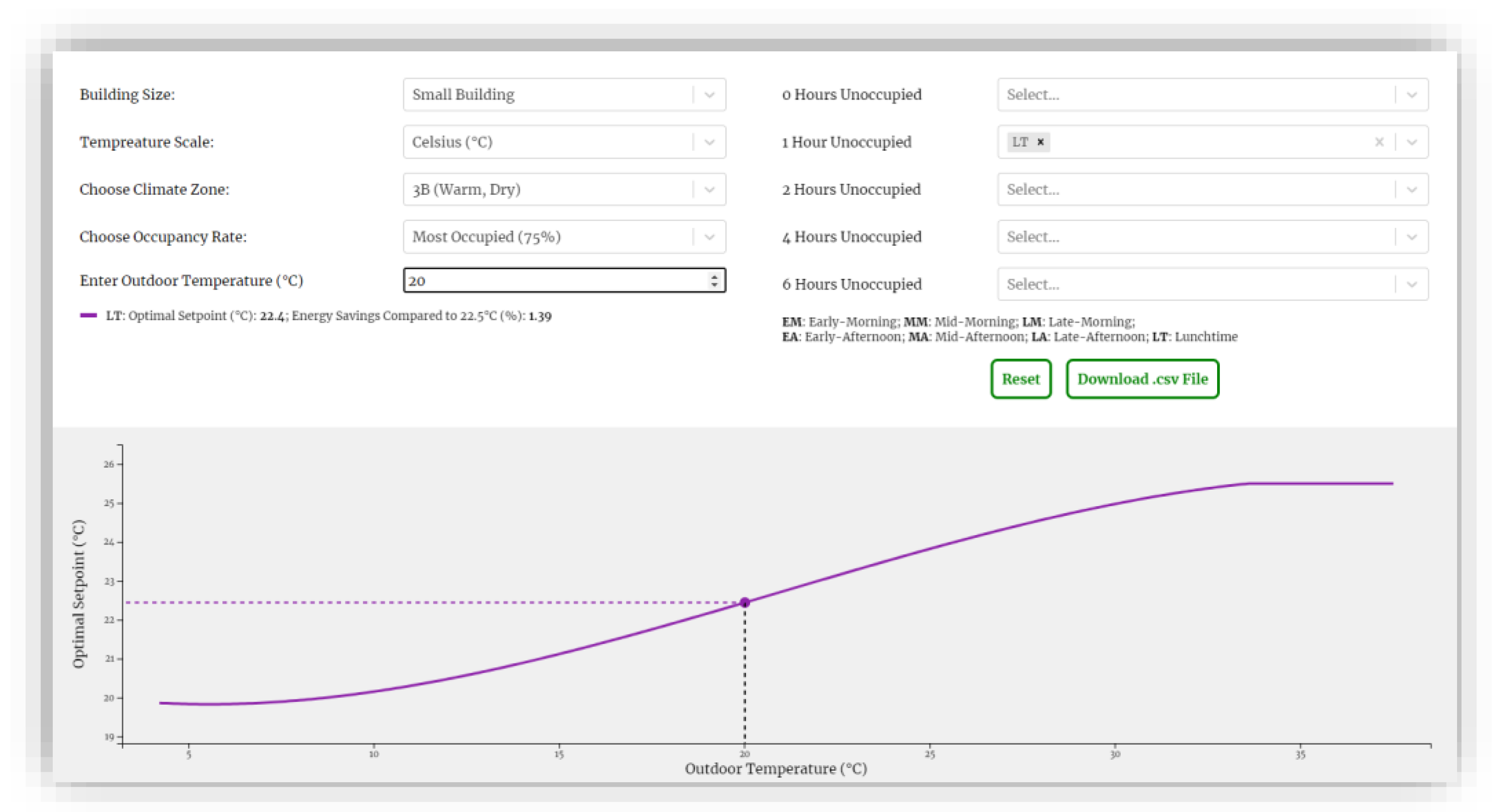1. Introduction
Heating, Ventilation, and Air Conditioning (HVAC) systems are responsible for approximately 40% of the total energy consumption in buildings, making them the most energy-intensive service and a significant contributor to greenhouse gas emissions [
1]. HVAC systems often employ closed-loop controllers that are regulated by temperature setpoints [
2], which directly influence energy consumption and occupants’ thermal comfort [
3,
4]. Temperature setpoints are typically selected by facility managers based on prevailing standards and guidelines [
5,
6,
7,
8] and often remain fixed unless occupants raise a complaint [
8,
9]. In addition, most HVAC systems operate based on static occupancy schedules [
10] that often assume maximum occupancy during working hours [
11]. However, occupancy behavior is stochastic and can deviate substantially from these set values [
12], often leading to unnecessary air conditioning [
13,
14,
15]. The issue of HVAC systems operating on fixed schedules that do not match actual building occupancy is further amplified by growing workplace flexibility and remote working trends, triggered by the COVID-19 pandemic. Even after the pandemic restrictions are mostly lifted, about 25% of workers are expected to continue remote work either partially or fully [
16]. With more flexible working hours, unoccupied periods might increase, and occupancy rates might drop. Consequently, leveraging occupancy data to select HVAC temperature setpoints could provide a promising solution to reduce energy waste without negatively impacting occupant comfort.
Previous studies often utilize occupancy data in the form of occupancy presence to select fixed temperature setpoints during occupied periods, and fixed setbacks when unoccupied [
17,
18,
19,
20,
21,
22,
23], as guided by ASHRAE 36 [
24]. The adoption of the highest or lowest setpoint and setback is widely used to minimize the heat transfer with outdoors and, thereby, energy consumption in hot or cold climates, respectively. By adopting the rule-based setpoint/setback selection strategies, these studies achieved 20% energy savings, on average. However, even if there was no change to setpoints (i.e., no setbacks), the lower occupant-generated heat loads at lower occupancy would provide up to a 4.34% energy reduction, on average [
25], that is currently not reported or acknowledged by these studies. Nevertheless, there is an additional energy-saving potential of shifting from fixed to optimally selected setpoints and setbacks with respect to occupancy and weather. This occurs at outdoor temperatures where variations in occupancy heat loads prompt buildings to fluctuate across cooling, free-running, and heating mode, and optimal setpoint and setback might not always be the lowest or highest [
25]. Selecting the optimal temperature setpoints and setbacks in response to changes in occupancy and outdoor weather conditions can, therefore, minimize the HVAC energy required to maintain a heat balance between indoor heat loads (governed mainly by varying occupancy) and outdoor heat transfer (governed mainly by outdoor air temperature) [
26,
27,
28,
29,
30]. In addition, it is important to consider the potential impact of rapid switching between temperature setpoints and setbacks which can cause frequent on–off cycles of HVAC equipment, resulting in increased energy consumption. Therefore, augmenting HVAC systems operation through optimal selection of temperature setpoints and setbacks with respect to occupancy and weather variability could minimize heat transfers and perturbations, thereby enhancing system stability and minimizing HVAC energy consumption.
This paper systematically compares energy savings from fixed and optimal HVAC temperature setpoints and setbacks across wide-ranging occupancy scenarios. Three setpoint and setback selection strategies are investigated: (1) a conventional fixed setpoint and setback, (2) optimal setpoint and fixed setback, and (3) optimal setpoint and setback. Four scenarios as proxies for the building occupancy rate (100%, 75%, 50%, 25% of the maximum occupancy) and 14 patterns (unoccupied periods from 0 to 6 h) were generated to account for increasing workplace flexibility and remote working trends. Three U.S. DOE energy models of office buildings were simulated across 17 climates to account for variations in building sizes (small, medium, and large) and a wide variety of outdoor air temperatures. Seven setpoints with an interval of 1 °C between 19.5 °C and 25.5 °C were investigated during occupied periods, with two setbacks for heating (17 °C and 19 °C) and two for cooling (26 °C and 28 °C), implemented during unoccupied periods. An exhaustive search algorithm was adopted to determine the optimal setpoint and setback temperature based on variations in occupancy and weather, i.e., setpoint and setback that minimizes HVAC energy usage during occupied and unoccupied periods, respectively.
In this study, the HVAC system is controlled through setpoints and setbacks falling within a range of temperatures that guarantee thermal satisfaction [
29,
30]. This approach allows to reformulate the optimization problem, treating the minimization of energy consumption as a single objective while carefully constraining thermal comfort. Therefore, rather than tackling the complex interplay of energy and thermal comfort as a multi-objective problem, this approach strikes a balance to investigate energy efficiency without compromising occupant thermal satisfaction. This can be achieved since occupants experience comfort within a nuanced spectrum of thermal conditions [
31]. Various human-related and environmental factors, including acclimation and weather conditions, exert influence on thermal comfort, rendering it a dynamic parameter and susceptible to alteration over time [
32,
33]. However, the capacity for adaptation is a key feature of human response to uncomfortable changes, aligning with the fundamental concept of adaptive thermal comfort [
31]. Therefore, leveraging the adaptive capabilities of occupants within the optimization framework enables to quantify the maximum potential for energy savings by investigating the variation of optimal temperature setpoints and setbacks across varying occupancy scenarios, without compromising thermal comfort. The structure of this paper is as follows.
Section 2 reviews the literature focusing on research exploring energy savings achieved with the selection of setpoint and setback temperatures and extrapolates the gaps in research.
Section 3 outlines the methodological workflow employed in the study, covering the generation of the data, data mining, followed by the evaluation framework.
Section 4 presents and discusses the findings, while the limitations of this study and suggestions for future research are highlighted in
Section 5.
Section 6 provides a breakdown of the results and serves as the concluding section of the study.
2. Literature Review
In recognizing the dynamic landscape of energy efficiency measurement methodologies in buildings, this literature review is tailored to encompass studies specifically focused on energy savings achieved through HVAC temperature setpoint and setback strategies, offering a targeted exploration of our primary research objective. Acknowledging the effects of temperature setpoints on HVAC energy consumption, several research efforts focused on the development of various smart setpoint selection strategies and control systems in order to reduce energy consumption over the past few years. HVAC systems typically operate through a univariate control logic, which triggers cooling or heating with respect to a single input (temperature setpoint) and single output (indoor air temperature) [
34]. Hence, the setpoint is treated as a singular parameter, without separate exploration of heating and cooling setpoints. In general, the simplest approach to achieve energy conservation is by widening temperature setpoints. This broadens the spectrum of temperatures within which HVAC systems function, subsequently reducing heating and cooling demand. Hoyt et al. [
35] quantified energy reduction resulting from decreasing the reference heating setpoint (21.1 °C) up to 17.7 °C and raising the cooling setpoint (22.2 °C) up to 30 °C. This analysis was performed across a set of six medium-sized offices simulated across seven climates of the U.S. The findings revealed that by raising the reference cooling setpoint to 25 °C and lowering the reference heating setpoint to 20 °C, 29% cooling energy savings and 34% for heating could be achieved, while maintaining acceptable temperature levels. It was also found that a broader setpoint temperature range of 18.3 °C to 27.8 °C could lead to energy savings of up to 73% of overall HVAC energy consumption. Although this research systematically quantified energy savings across diverse climate conditions, it is important to note that widening the temperature difference between heating and cooling setpoints would consistently result in energy savings. Furthermore, the optimal heating and cooling setpoints for specific climates remain unclear. Papadopoulos et al. [
28] addressed this gap by quantifying the energy saving potential of optimal heating and cooling setpoints in large office buildings across various climate zones, accounting for the trade-off between energy consumption and thermal comfort. For moderate to cold climate zones, it was found that thermostat setpoints selected based on international standards, such as ASHRAE 55 [
2] employed in DOE models, yield sub-optimal results. Specifically, energy savings of up to 60% can be achieved in moderate climates without compromising occupant thermal comfort, while minimal savings were highlighted in regions with high cooling loads. Nevertheless, the influence of outdoor weather on energy consumption at varying setpoints was not explored, and the energy savings were solely measured at fixed temperature setpoints. Ghahramani et al. [
36] suggested determining daily and yearly optimal setpoints based on weather fluctuations and investigated optimal setpoint selection across various building sizes, climate zones, and building vintages. Their findings indicated that daily optimal setpoints in the range of 22.5 ± 3 °C lead to savings of up to 16.4%, compared to a 22.5 °C baseline setpoint. Daily optimal setpoints resulted in energy savings ranging from 10.09% to 37.03% for small office buildings, 11.43% to 21.01% for medium office buildings, and 6.78% to 11.34% for large office buildings. While this study delves into the possibility of choosing optimal setpoints with respect to outdoor weather, it overlooks the influence of occupancy. In summary, none of the previous studies investigated optimal setbacks during unoccupied periods.
Research investigations into HVAC system controls that consider occupancy have encompassed the development of algorithms rooted in machine learning and model predictive control methodologies. In their evaluation conducted at the University of Florida, Goyal et al. [
20] analyzed a feedback controller and a model predictive control (MPC) system that incorporated real-time optimization of setpoints and setbacks. In comparison to a conventional controller, the study revealed that both occupancy-based approaches resulted in approximately 40% energy reduction. Importantly, these controls were able to achieve thermal comfort and maintain indoor air quality within acceptable levels. However, the setpoint for occupied periods was fixed at 21.1 °C and the static nighttime setback was set to 22.8 °C. In another study, Baldi et al. [
17] presented an occupancy-driven controller for setpoints and setbacks, employing three rules: a pre-cooling setpoint to activate the energy system before occupancy, a fixed setpoint of 24 °C and 25 °C during occupancy, and a setback of 30 °C during unoccupied periods. The findings indicated that compared to fixed pre-programmed approaches, this approach could achieve energy savings of 15% while simultaneously increasing the level of thermal satisfaction among occupants. Although the contribution of both setpoints and setbacks was included in the quantification of the energy-saving potential, heating and cooling were supplied at fixed temperatures during occupied or unoccupied periods. A step forward in the development of dynamic setpoints dependent on occupancy is represented by the research conducted by Wang et al. [
37] where they optimized HVAC temperature setpoints using predicted internal heat gain values. The occupancy-driven optimal algorithm demonstrated energy reductions of up to 36.8% for heating and 33.9% for cooling. Furthermore, it was noted that occupant discomfort lessened by 3–5% during summer and winter, respectively. While this study showcased the advantages of optimal setpoints with respect to occupancy, it did not take into account the influence of outdoor temperatures, concentrating solely on modifying the setpoint in response to internal heat generation. Finally, Peng et al. [
22] conducted a study that delved into the adoption of occupancy data to deduce cooling setpoints in real time. They implemented a learning-based controller in 11 office rooms, which encompassed a range of typical office scenarios. The findings demonstrated energy savings ranging from 7% to 52% compared to a conventional controller for cooling systems. This study investigated four occupancy patterns, each with distinct arrival and departure times, and total occupied durations and assigned setpoints or setbacks, respectively. However, this study evaluated a control algorithm based on rules and static temperatures, offering just four temperature choices: a comfort temperature setpoint, a setback 1 °C higher than the comfort temperature, a deep setback 0.5 °C higher than the setback, and a 35 °C economy temperature. While previous studies investigated varying the setpoint based on outdoor temperature or estimated energy savings depending on occupancy, there is a lack of research focusing on the combined effects of outdoor temperature and occupancy variability.
The existing literature investigating energy efficiency in buildings using setpoints and setbacks has predominantly focused on rule-based strategies utilizing fixed temperature setpoints and setbacks based on occupancy presence. While these studies have demonstrated significant average energy savings, the literature lacks exploration into the additional energy-saving potential that arises from transitioning to optimally selected setpoints and setbacks, considering the dynamic interplay between occupancy and outdoor weather conditions. The significance of this gap lies in the potential for minimizing HVAC energy consumption by selecting temperature setpoints and setbacks in response to changes in occupancy and outdoor conditions, thereby achieving a more nuanced balance between indoor heat loads and outdoor heat transfer. Additionally, the literature currently overlooks the potential impact of rapid switching between temperature setpoints and setbacks on HVAC system stability, presenting an avenue for further investigation. This gap underscores the need for comprehensive investigations that integrate both outdoor temperature fluctuations and occupancy dynamics, providing a more holistic understanding of the factors influencing optimal setpoints and setbacks for HVAC systems in buildings.
3. Methodology
The methodological approach in this study involves three key components: (1) data generation: it defines the investigated factors and their values (
Section 3.1); (2) data mining: it presents the simulation process and the identification of optimal setpoints and setbacks and respective energy usages, in
Section 3.2; and (3) evaluation framework: it illustrates the computation of energy savings resulting from 3 selection strategies (
Section 3.3). A total of 7 temperature setpoints and 4 setbacks, 14 unoccupied patterns and 4 occupancy rates, 17 climates and 3 building sizes are explored (
Section 3.1). This study used the U.S. Department of Energy (DOE) reference office buildings (small, medium, and large) energy simulation models which are compatible with EnergyPlus software version 8.9 [
38]. This paper evaluates 3 setpoint and setback selection strategies: a conventional fixed setpoint and setback, optimal setpoint with fixed setback, and optimal setpoints and setbacks (
Figure 1) and quantifies the resulting energy savings compared to a baseline value of 22.5 °C (
Section 3.3).
3.1. Data Generation
The variables and the corresponding investigated values are presented in
Table 1. To discretize the temperature setpoints, a 1 °C interval was assigned to seven values ranging from 19.5 °C to 25.5 °C. The range was chosen based on temperatures that enable occupants to remain thermally comfortable [
5,
6]. Given that setbacks should fall outside the setpoint range, this paper explored them by selecting two values lower than the lowest setpoint (19.5 °C), 17 °C and 19 °C for heating, and higher than the highest setpoint (25.5 °C), 26 °C and 28 °C for cooling. In order to represent variations in occupant heat loads, this research defined 4 ratios as proxies for the average rate of occupancy with respect to a fully occupied building (100%), namely 25%, 50%, 75%, and 100%. The occupancy rates are to be considered homogeneous throughout the occupied periods, allowing the quantification of maximum potential energy savings, achievable while reducing uncertainty due to the stochastic behavior of occupants.
Figure 2 depicts the investigated 14 unoccupied patterns across five unoccupied periods (0 h, 1 h, 2 h, 4 h, and 6 h). They represent different distributions of unoccupied periods that account for growing workplace flexibility and remote working trends in office buildings. They were defined according to a rule-based strategy by iterating the length (from 0 to 6 h), frequency (from a single unoccupied period to multiple unoccupied periods), and distribution (early morning: 8–10 a.m., late morning: 10 a.m.–12 p.m., early afternoon: 2–4 p.m., late afternoon: 4–6 p.m.) of unoccupied periods.
In total, 17 different climates ranging from extremely hot and humid (0A) (Singapore) to subarctic (8) (Fairbanks, Alaska) were simulated to generalize the findings across a range of climate zones. In addition, the investigation across various climates allows the selection of optimal setpoints and setbacks with respect to a wide range of outdoor air temperatures. To study the effects of outdoor conditions on the size and geometry of buildings, the study encompasses 3 building sizes: a small, single-story building, a medium-sized building with 3 floors, and a large, twelve-story building. Since smart control systems can only be operated in modern energy systems, only newly built buildings (after 2004) were included. These models accurately simulate building construction materials and methods, adjusting roof and wall U-values, slab-on-grade and underground R-values, window U-values, and solar heat gain coefficients (SHGCs), in accordance with prevailing climate conditions. Furthermore, these models incorporate various energy systems based on specific building types.
Figure 3 portrays the small, medium, and large office buildings.
Table 2 details the construction materials and equipment systems based on ASHRAE standards 90.1-2004 and 62.1-2004 [
38].
The reference building models are assigned HVAC operational profiles that align with the occupancy patterns under investigation. On weekdays, setpoints are assigned for occupied periods, with setbacks applied during unoccupied periods. On Saturdays, Sundays, and holidays, the HVAC system remains off throughout the entire day.
3.2. Data Mining
The daily energy consumption for every combination of variables was simulated to determine daily optimal setpoints, as they provide energy savings compared to annual setpoints [
36] and can dynamically respond to outdoor temperatures and occupancy variations. Weekends and holidays were not considered since offices are mostly unoccupied, which leads to the HVAC systems being either turned off or operated for a shorter period compared to patterns identified above. In order to sample the whole search space, an exhaustive (full factorial) approach was utilized to generate the solutions (79,968 combinations: 7 setpoints × 4 setbacks × 4 occupancy rates × 14 unoccupied patterns × 3 building sizes × 17 climates). The daily optimal setpoints and setbacks are temperatures that minimize the energy required by the energy system to maintain a heat balance between the interior and exterior environment and are constrained to a defined range (i.e., constraints in Equations (1) and (2)). The exhaustive search algorithm analyzes the energy consumption resulting from various temperature setpoints and setbacks. It then identifies the combination with the lowest energy consumption along with its associated setpoint and setback values for each permutation of unoccupied pattern and occupancy rate. The exhaustive search algorithms (Equations (1) and (2)) identify the daily optimal setpoint and setback and the associated energy consumptions for (1) optimal setpoint with fixed setback strategy and (2) optimal setpoint and setback strategy. The conventional fixed strategy entails a temperature setpoint of 22.5 °C, while the heating and cooling setbacks are, respectively, 17 °C and 28 °C. Note that this study covers analyses across diverse climates where building envelope parameters are adjusted based on distinct climate conditions to establish broad applicability. Due to space limitations, reported energy savings are averaged across climates, recognizing the varied thermal loads associated with different building envelopes in these regions.
Optimal setpoint and fixed setback strategy: Subject to 19.5 °C < SP < 25.5 °C,
i = 1:365
Optimal setpoint and setback strategy: Subject to 19.5 °C < SP < 25.5 °C
Subject to 15 °C < SBheating < 19 °C, 26 °C < SBcooling < 30 °C
SP = Daily Setpoint,
SBheating = Daily Setback for heating,
SBcooling = Daily Setback for cooling,
OT = Daily Outdoor Air Temperature,
OR = Daily Occupancy Rate.
EnergyPlus simulations were executed using the Python programming language, with each simulation employing a customized building energy model file (.idf file) run with parallel computing techniques to reduce the computational time. The script systematically scanned the text file of each model to identify the variables, and their values were replaced in a parametric manner.
3.3. Setpoints and Setbacks and Energy Evaluation Framework
In order to ensure an equitable assessment of different setpoint selection strategies, this study quantifies the effect of reduced heat loads during lower occupancy rates and extended unoccupied periods on HVAC energy consumption. This portion of savings occurs regardless of adopting any setpoint selection strategy. The average daily energy reduction resulting from occupancy heat loads was determined in relation to the HVAC energy consumption observed in a building that remained continuously occupied (no unoccupied periods), and at 100% occupancy (used as the baseline reference). The variation in HVAC energy consumption for each change in occupancy rate and unoccupied period, when compared to the baseline, was calculated as a percentage of savings using Equation (3).
where:
= reference daily energy usage from 0 unoccupied periods, at 100% occupancy rate.
= daily energy consumption at 1 h, 2 h, 4 h and 6 h unoccupied period and 75%, 50% and 25% occupancy rate.
Subsequently, the additional average daily energy saving resulting from each selection strategy was computed. The energy savings across occupancy rates and unoccupied periods were determined with respect to the HVAC energy consumption when fixed setpoints were applied (used as baseline reference). The variance in HVAC energy consumption between the energy usage resulting from each selection strategy at various occupancy rates and unoccupied periods, compared to the baseline, was computed as a percentage of savings using Equation (4).
where:
x = setpoint and setback selection strategy (fixed setpoint and setback, optimal setpoint and fixed setback, optimal setpoint and setback).
= baseline daily energy consumption for a fixed setpoint strategy at 0 h, 1 h, 2 h, 4 h and 6 h unoccupied period and 75%, 50% and 25% occupancy rate.
= daily energy consumption for each selection strategy at 0 h, 1 h, 2 h, 4 h and 6 h unoccupied period and 75%, 50% and 25% occupancy rate.
5. Limitations and Recommendations for Future Research
Although this paper explored a relatively wide-ranging set of occupancy rates and patterns (4 × 16 = 64 occupancy scenarios), they represent a finite number of scenarios due to the computational expense of energy simulation. In addition, they represent proxies for building occupancy and may not fully capture the nuances of real-world occupancy dynamics and patterns within buildings. In reality, the rate of occupancy in the zones and the occupied or unoccupied patterns are not constant but vary stochastically, dictated by occupant behaviors. Furthermore, although the study simulates three different building sizes (small, medium, and large) across 17 climate zones, the extent to which findings can be generalized across diverse building types is limited to office settings. Moreover, exhaustive search algorithms are computationally intensive. The feasibility of implementing such an algorithm in real-world HVAC control systems may be challenging due to potential time and resource constraints. In addition, this study assumed uniform temperature setpoints/setbacks across all building zones. However, a more detailed spatial and temporal resolution could increase energy savings and might enhance the effectiveness of HVAC operation. For example, heightened solar heat gain in a zone positioned at a building’s perimeter could influence the optimal setpoint and setback. Similarly, the heat loads from diverse occupancy rates, patterns, appliances, and lighting systems may vary among different zones based on their unique end uses. Furthermore, it could be possible to compute optimal values on an hourly basis or group them according to specific periods, such as “seasons”. Further research is needed to define periods based on similar variations in outdoor air temperatures. Nevertheless, when making decisions about the selection of spatial and temporal granularity, considering the balance between the controller’s complexity and the potential energy savings is of utmost importance.
While this paper serves a basis to provide a systematic methodology to study the of impact of varying occupancy on optimal setpoints and setbacks, future research could focus on specific use cases and develop and implement techniques that can efficiently select optimal setpoints and setbacks depending on outdoor weather and occupancy variability. Given that exhaustive search methods are impractical for real building HVAC controllers, we anticipate the emergence of data-driven algorithms for HVAC operation that rely on minimal data prerequisites. Further research efforts will focus on the development of a data-driven algorithm based on occupancy and weather and its deployment in a real-world office setting. The findings will be compared against simulated data to provide insights of the actual energy consumption data and potential savings. Adaptive predictive control algorithms based on machine learning will be incorporated in future research. This will include the forecasting of occupancy and weather to enhance the responsiveness of HVAC systems and the ability to learn from historical data to refine predictions and adapt over time. By leveraging IoT devices and real-time data analysis, building management systems can create a responsive and adaptive environment that not only validates optimal setpoints but also continually refines them based on evolving conditions. Further research avenues will include a comprehensive assessment of maintenance practices, considering their influence on the long-term reliability of HVAC systems, to ascertain practical viability of the optimization of setpoints and setbacks based on outdoor weather and occupancy. As maintenance plays a pivotal role in sustaining the efficiency and functionality of HVAC systems over time, this evaluation will involve a detailed examination of how these systems perform under varying conditions and stresses based on real-world scenarios. Furthermore, the assessment under recommended setpoints and setbacks will provide valuable insights into potential challenges and practical implications. Integrating optimal setpoint and setback strategies within a broader EMS necessitates a holistic evaluation to identify and capitalize on synergies, while also addressing potential conflicts with other energy-saving strategies and operational considerations. This approach, ensuring a comprehensive and optimized energy management solution, will be investigated in future research.
6. Conclusions
This study systematically compared the energy-saving potential between fixed and optimal HVAC temperature setpoints and setbacks under typical occupancy scenarios. Three strategies were examined: conventional fixed setpoints and setbacks, optimal setpoints with fixed setbacks, and optimal setpoints and setbacks. The investigation considered four occupancy rates (25%, 50%, 75%, 100%) and 14 patterns (unoccupied periods from 0 to 6 h) to reflect workplace flexibility and remote working trends. Seven setpoints (19.5–25.5 °C at 1 °C intervals) were explored during occupied periods, with two heating (17 °C and 19 °C) and two cooling (26 °C and 28 °C) setbacks during unoccupied periods. U.S. DOE reference models for small, medium, and large office buildings were simulated for 17 climate zones to account for a wide variety of outdoor air temperatures. An exhaustive search algorithm was adopted to determine the optimal setpoint and setback temperature based on variations in occupancy and weather, i.e., setpoint and setback that minimizes HVAC energy usage during occupied and unoccupied periods, respectively. Energy reduction due to occupant heat loads and the additional savings from each setpoint and setback selection strategy were calculated in comparison to the sole implementation of fixed setpoints regardless of flexible occupancy. The primary findings are outlined as follows:
Occupant heat loads results in a 5.48% energy reduction for lower occupancy rates and during longer unoccupied periods. In addition, a conventional fixed setpoint and setback selection strategy provides 11.80% energy savings, optimal setpoint selection provides 34.36% savings, and simultaneous optimization of setpoints and setbacks provides 38.08% savings.
Optimal setpoints (19.5 °C and 25.5 °C) remain constant regardless of occupancy, for outdoor temperatures below 5 °C and above 32 °C. However, in the case of outdoor temperatures spanning from 5 °C to 32 °C, fluctuations in occupancy can shift buildings between cooling, free-running, and heating modes.
A lower occupancy rate (25%) results in a 1 °C lower or higher optimal setpoint compared to a fully occupied building (100% occupancy rate) for heating and cooling, respectively. Optimal setpoints for a predominantly unoccupied building (6 h) were found to be, on average, 2 °C lower or higher compared to the optimal setpoint identified for a building occupied all the time (no unoccupied hours) for heating and cooling, respectively.
When simultaneously optimizing setpoints and setbacks, the effect of varying occupancy on optimal setpoints is lower compared to optimal setpoints and fixed setbacks (
Figure 11). This results in a significant portion of identical optimal setpoints, regardless of the duration of unoccupied periods and occupancy rates.
The energy savings trends for various setpoint and setback selection strategies remain consistent across patterns with continuous or intermittent occupancy for short unoccupied periods (up to 4 h), where occupancy rates impact energy consumption. However, during longer unoccupied periods (6 h), the influence of occupancy rates becomes insignificant, and the adoption of different setpoint and setback strategies affects energy consumption across patterns, resulting in varying energy savings. In such cases, rapid changes in setpoints and setbacks during periods characterized by high heat loads may not allow sufficient time for the system to reach and maintain the desired temperature, leading to system destabilization and reducing energy savings by up to 9.33%.
The results presented in this paper can assist stakeholders in the building industry in evaluating the energy savings that can be obtained by integrating weather and occupancy data into fixed and optimal setpoint and setback selection strategies. Moreover, this research establishes the groundwork for future research avenues focused on developing efficient techniques for selecting optimal HVAC setpoints and setbacks based on outdoor weather and occupancy variability, moving beyond exhaustive search methods to embrace data-driven algorithms with minimal prerequisites. This includes deploying and validating such algorithms in real-world office settings, integrating adaptive predictive control algorithms based on machine learning for enhanced system responsiveness, and conducting a comprehensive assessment of maintenance practices’ impact on HVAC system reliability. Additionally, further research will explore the integration of optimal setpoint and setback strategies within broader Energy Management Systems for a comprehensive evaluation of energy management solutions.
